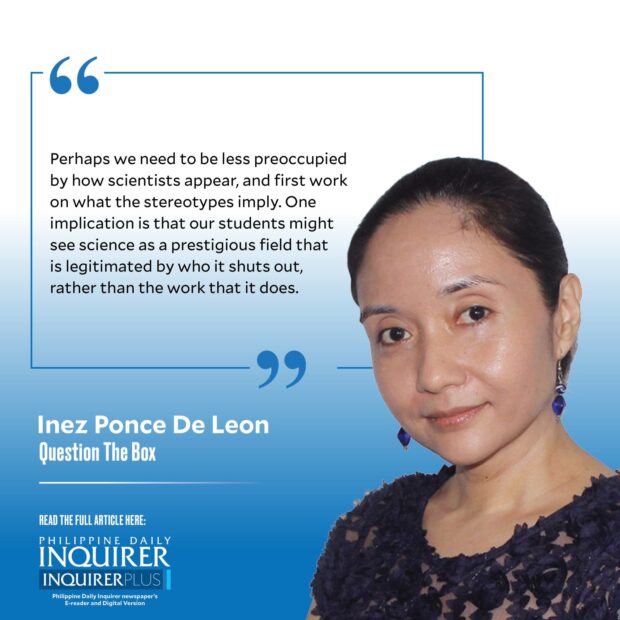Escaping toxic exclusivity

Last weekend, as the world celebrated the International Day of Women and Girls in Science, a news outfit released a graphic online with the faces of female academicians, calling for readers to give importance to female scientists.
While some internet users appreciated the gesture, others asked why only older Ph.D.’s were featured. What about those who had never earned a doctorate? Younger scientists? Those who work abroad? I would have asked, as well: why not our social scientists, who are as systematic in their work?
Some scientists claimed that this image of science, dominated by old people with higher degrees, might make young people perceive science as a nonviable career, one that another generation is in charge of.
Article continues after this advertisementHow people define “scientist,” and, by extension, perceive science, has long been studied in research. The most famous example is the Draw-a-Scientist Test (DAST) developed by David Wade Chambers, which determines when children first know about the stereotypical image of the scientist.
Since the first 1983 DAST, research has repeatedly shown that students across the world use ideas from television shows, textbook pictures, and their own upbringing to draw what they believe is a scientist: an old white male, with facial and/or unkempt hair, in glasses, dressed in a white lab gown.
An interpretation of the ubiquitous White Unwashed Nerdy Male in Lab Coat drawing is that children see people of a specific ethnicity and gender as most equipped to be scientists; other ethnicities and genders are then thought to be unqualified, or, as a study on Turkish and Taiwanese students showed, too traditional for the progressive nature of science.
Article continues after this advertisementI took a similar tack as I asked scientists to talk about themselves back in 2010 when I interviewed Filipino and United States scientists for my dissertation. I sought to elucidate the cultures of science, and, among others, connect this culture to scientists’ views about the role of science in society.
In the Philippines, most scientists believed their work was special, and that very few nonscientists practiced systematic, rational thinking. They also believed that social scientists could not be considered scientists: they had no power to predict phenomena, were not elegant in writing their findings, did not know enough about what they were studying to be deemed real experts.
There was no such snobbery in the US. Scientists saw themselves as professionals among many other specialists. There was nothing unique about their work, the scientists said; even chefs had step-by-step ways of figuring out good recipes, and even social scientists had their own logical progression of research. Every scientist was blind to fields other than their own.
Over a decade later, I still look back on the data and find new insights, one of which came to the fore last weekend. Beyond bringing more gender diversity into the sciences, perhaps we also need to ask how the sciences have (willingly or unwillingly, knowingly or unknowingly) shut out other fields of expertise and legitimate knowledge—how science has focused so much on doing, that it has also failed to listen. Has this exclusion also alienated all kinds of people from taking an interest in science?
Perhaps we need to be less preoccupied by how scientists appear, and first work on what the stereotypes imply.
One implication is that our students might see science as a prestigious field that is legitimated by who it shuts out, rather than the work that it does. Another: that one simply needs to appear a certain way to be called a scientist, and that assuming the title is enough without taking on the responsibility of producing systematic research.
Something that one of my US respondents said also came back as I watched the news on France 24 last weekend. France 24 covered the ground offensive of Rafah by the Israeli army. Rafah is the lifeline to aid, a supposed safe zone where Palestinians were told to flee; it is now a death trap.
The news centered on a 15-year-old boy living with his family in a tent in the border city. He had scavenged through the rubble and trash to find fan blades, wires, and batteries; he made a windmill, which would give his family light on the dark winter night.
Children are the best scientists, my US respondent once said. They ask questions. They don’t focus on constraints. They take joy in discovery.
That is the image of science that should speak to us. Not the bomb makers or the artillery designers or the world leaders who withdraw or proclaim their support for this or that country, this or that agency, without first waiting for evidence.
A child, unafraid, working with what is on hand.
Perhaps that’s what we first need to train our children to do: dream, question, recognize problems, try to solve them with whatever is available, test a solution, perfect it. Then they can go into the sciences, where they can continue to be children, where their discoveries protect lives, and where their careers exclude no one.
—————-
iponcedeleon@ateneo.edu
















